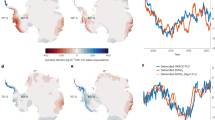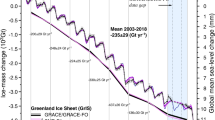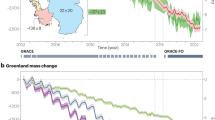Abstract
The Greenland and Antarctic ice sheets have been reported to be losing mass at accelerating rates1,2. If sustained, this accelerating mass loss will result in a global mean sea-level rise by the year 2100 that is approximately 43 cm greater than if a linear trend is assumed2. However, at present there is no scientific consensus on whether these reported accelerations result from variability inherent to the ice-sheet–climate system, or reflect long-term changes and thus permit extrapolation to the future3. Here we compare mass loss trends and accelerations in satellite data collected between January 2003 and September 2012 from the Gravity Recovery and Climate Experiment to long-term mass balance time series from a regional surface mass balance model forced by re-analysis data. We find that the record length of spaceborne gravity observations is too short at present to meaningfully separate long-term accelerations from short-term ice sheet variability. We also find that the detection threshold of mass loss acceleration depends on record length: to detect an acceleration at an accuracy within ±10 Gt yr−2, a period of 10 years or more of observations is required for Antarctica and about 20 years for Greenland. Therefore, climate variability adds uncertainty to extrapolations of future mass loss and sea-level rise, underscoring the need for continuous long-term satellite monitoring.
This is a preview of subscription content, access via your institution
Access options
Subscribe to this journal
Receive 12 print issues and online access
$259.00 per year
only $21.58 per issue
Buy this article
- Purchase on Springer Link
- Instant access to full article PDF
Prices may be subject to local taxes which are calculated during checkout



Similar content being viewed by others
References
Velicogna, I. Increasing rates of ice mass loss from the Greenland and Antarctic ice sheets revealed by GRACE. Geophys. Res. Lett. 36, L19503 (2009).
Rignot, E., Velicogna, I., van den Broeke, M. R., Monaghan, A. & Lenaerts, J. Acceleration of the contribution of the Greenland and Antarctic ice sheets to sea level rise. Geophys. Res. Lett. 38, L05503 (2011).
Bamber, J. L. & Aspinall, W. P. An expert judgement assessment of future sea level rise from the ice sheets. Nature Clim. Change 3, 424–427 (2013).
Anthoff, D., Nicholls, R. & Tol, R. S. The economic impact of substantial sea-level rise. Mitig. Adapt. Strategies Glob. 15, 321–335 (2010).
Meehl, G. et al. Climate Change 2007: The Physical Science Basis (Cambridge Univ. Press, 2007).
Van den Broeke, M. et al. Partitioning recent greenland mass loss. Science 326, 984–986 (2009).
Moon, T., Joughin, I., Smith, B. & Howat, I. 21st-century evolution of greenland outlet glacier velocities. Science 336, 576–578 (2012).
Meier, M. F. et al. Glaciers dominate eustatic sea-level rise in the 21st century. Science 317, 1064–1067 (2007).
Hu, A., Meehl, G., Han, W. & Yin, J. Effect of the potential melting of the Greenland Ice Sheet on the meridional overturning circulation and global climate in the future. Deep-Sea Res. Pt. II 58, 1914–1926 (2011).
Hanna, E. et al. Greenland Ice Sheet surface mass balance 1870 to 2010 based on Twentieth Century Reanalysis, and links with global climate forcing. J. Geophys. Res. 116, D24121 (2011).
Sasgen, I., Dobslaw, H., Martinec, Z. & Thomas, M. Satellite gravimetry observation of Antarctic snow accumulation related to ENSO. Earth Planet. Sci. Lett. 299, 352–358 (2010).
Van den Broeke, M. & Lipzig, N. P. M. Changes in Antarctic temperature, wind and precipitation in response to the Antarctic Oscillation. Ann. Glaciol. 39, 119–126 (2004).
Holland, D., Thomas, R., de Young, B., Ribergaard, M. & Lyberth, B. Acceleration of Jakobshavn Isbrae triggered by warm subsurface ocean waters. Nature Geosci. 1, 659–664 (2008).
Hanna, E. et al. Hydrologic response of the Greenland ice sheet: The role of oceanographic warming. Hydrol. Processes 23, 7–30 (2009).
Sohn, H-G., Jezek, K. C. & van der Veen, C. J. Jakobshavn Glacier, west Greenland: 30 years of spaceborne observations. Geophys. Res. Lett. 25, 2699–2702 (1998).
Straneo, F. et al. Impact of fjord dynamics and glacial runoff on the circulation near Helheim Glacier. Nature Geosci. 4, 322–327 (2011).
Zwally, H. J. et al. Greenland ice sheet mass balance: Distribution of increased mass loss with climate warming; 2003–07 versus 1992–2002. J. Glaciol. 57, 88–102 (2011).
Shepherd, A. et al. A reconciled estimate of ice-sheet mass balance. Science 338, 1183–1189 (2012).
Wouters, B., Chambers, D. & Schrama, E. GRACE observes small-scale mass loss in Greenland. Geophys. Res. Lett. 35, L20501 (2008).
Sasgen, I. et al. Antarctic ice-mass balance 2002 to 2011: Regional re-analysis of GRACE satellite gravimetry measurements with improved estimate of glacial-isostatic adjustment. Cryosphere Discuss. 6, 3703–3732 (2012).
A, G., Wahr, J. & Zhong, S. Computations of the viscoelastic response of a 3-D compressible Earth to surface loading: An application to Glacial Isostatic Adjustment in Antarctica and Canada. Geophys. J. Int. 192, 557–572 (2013).
Wahr, J., Swenson, S. & Velicogna, I. Accuracy of GRACE mass estimates. Geophys. Res. Lett. 33, L06401 (2006).
Van Meijgaard, E. et al. The KNMI Regional Atmospheric Climate Model RACMO Version 2.1 Tech. Rep., KNMI, De Bilt, The Netherlands (Koninklijk Nederlands Meteorologisch Instituut, 2008).
Ettema, J. et al. Higher surface mass balance of the Greenland ice sheet revealed by high-resolution climate modeling. Geophys. Res. Lett. 36, L12501 (2009).
Lenaerts, J. T. M., van den Broeke, M. R., van de Berg, W. J., van Meijgaard, E. & Kuipers Munneke, P. A new, high-resolution surface mass balance map of Antarctica (1979–2010) based on regional atmospheric climate modeling. Geophys. Res. Lett. 39, L04501 (2012).
Schwarz, G. Estimating the dimension of a model. Ann. Stat. 6, 461–464 (1978).
Emmert, J. T. & Picone, J. M. Statistical uncertainty of 1967–2005 thermospheric density trends derived from orbital drag. J. Geophys. Res. 116, A00H09 (2011).
Weatherhead, E. C. et al. Factors affecting the detection of trends: Statistical considerations and applications to environmental data. J. Geophys. Res. 103, 17149–17161 (1998).
Acknowledgements
The GRACE processing centres are acknowledged for processing and sharing the GRACE data. We thank G. A, R. Riva and P. Stocchi for providing glacial isostatic adjustment models and E. Rignot for the Greenland ice discharge data. B.W. is financially supported by a Marie Curie International Outgoing Fellowship within the 7th European Community Framework Programme (FP7-PEOPLE-2011-IOF-301260). I.S. would like to acknowledge support from the German Research Foundation (DFG) through grant SA 1734/2-2. J.L.B. was supported by NERC grant NE/I027401/1.
Author information
Authors and Affiliations
Contributions
B.W. developed the idea and methodology and wrote the article. I.S. provided the GRACE data for Antarctica, J.T.M.L. and M.R.v.d.B. provided the SMB data and J.L.B. developed the methodology to calculate the ice discharge. All authors discussed and commented on the manuscript and methodology.
Corresponding author
Ethics declarations
Competing interests
The authors declare no competing financial interests.
Supplementary information
Supplementary Information
Supplementary Information (PDF 4828 kb)
Rights and permissions
About this article
Cite this article
Wouters, B., Bamber, J., van den Broeke, M. et al. Limits in detecting acceleration of ice sheet mass loss due to climate variability. Nature Geosci 6, 613–616 (2013). https://doi.org/10.1038/ngeo1874
Received:
Accepted:
Published:
Issue Date:
DOI: https://doi.org/10.1038/ngeo1874
This article is cited by
-
Climate variability a key driver of recent Antarctic ice-mass change
Nature Geoscience (2023)
-
Applications and Challenges of GRACE and GRACE Follow-On Satellite Gravimetry
Surveys in Geophysics (2022)
-
Reconciling global mean and regional sea level change in projections and observations
Nature Communications (2021)
-
Climate-driven acceleration of glacier mass loss on global and regional scales during 1961–2016
Science China Earth Sciences (2021)
-
Antarctic ice mass variations from 1979 to 2017 driven by anomalous precipitation accumulation
Scientific Reports (2020)



